Case Report - (2023) Volume 31, Issue 5
Received: 29-Apr-2023, Manuscript No. IPQPC-23-16316; Editor assigned: 02-May-2023, Pre QC No. IPQPC-23-16316 (PQ); Reviewed: 16-May-2023, QC No. IPQPC-23-16316; Revised: 23-Oct-2023, Manuscript No. IPQPC-23-16316 (R); Published: 30-Oct-2023, DOI: 10.36648/1479-1064.31.5.36
Pulmonary Langerhans’ Cell Histiocytosis (PLCH) is an unusual cystic lung disease that is also characterized by extrapulmonary manifestations. The current review discusses the presenting features and relevant diagnostic testing and treatment options for PLCH in the context of a clinical case. While the focus of the present article is adult PLCH and its pulmonary manifestations, it is important for clinicians to distinguish the adult and pediatric forms of the disease, as well as to be alert for possible extrapulmonary complications. A major theme of the current series of articles on rare lung diseases has been the translation of insights gained from fundamental research to the clinic. Accordingly, the understanding of dendritic cell biology in this disease has led to important advances in the care of patients with PLCH.
Pulmonary langerhans cells histiocytosis; Smoking; Interstitial lung disease; Pneumothorax
Pulmonary langerhans cells histiocytosis is a rare interstitial lung disease usually occurring in the young adult population, with cigarette smoking being a major contributing factor. It can affect the lungs in isolation or be widespread as part of a multisystemic disease and is characterized by in iltration of tissues by bone marrow derived langerhans cells [1].
In this report, we describe two very different cases of the same condition a 29 years old male with a strong history of smoking who presented with a spontaneous pneumothorax the other, a 17 years old male non-smoker who presented similarly 2 months post SARS-CoV-2 pneumonia [2].
Synopsis: Two cases of pulmonary langerhans cells histiocytosis presenting to local hospitals with very different presentations and diagnostic approach are reviewed.
Case 1
A 29 years old Indo-Caribbean male, presented to the hospital for sudden onset, progressively worsening dyspnoea and let sided chest pain, described as being sharp in character. He was previously well, with no known medical conditions, and his family history was only positive for type 2 diabetes mellitus. He reported smoking half a pack of cigarettes per day for the past 10 years and was an occasional alcohol consumer. The Chest X-Ray (CXR) done on admission showed the presence of a let pneumothorax as well as non-specific bilateral interstitial changes, for which a le t chest drain was inserted. A repeat CXR post chest tube insertion showed reexpansion of the le t lung [3]. A chest high resolution CT scan showed severe bilateral pulmonary fibrosis.
Physical examination on admission showed a well appearing man, in minimal respiratory distress with vital signs within normal limits. Classic findings of a left pneumothorax were found on respiratory examination (decreased breath sounds throughout, resonant to percussion on the left) and cardiac auscultation, as well as abdominal examination were unremarkable.
A laboratory workup revealed a mildly elevated white cell count of 13 (normal range 4-11), normal hemoglobin levels (15 mg/dL), and a normal platelet count of 266. Renal function, as well as liver function tests were all within normal levels. ESR was mildly elevated at 15. However, ANA, ds-DNA, Anti CCP and rheumatoid factor levels were all negative.
He was discharged 5 days after admission to the thoracic medicine clinic with the discharge diagnosis of Interstitial Lung Disease (ILD). However, a repeat HRCT done at the clinic showed diffuse multiple thin-walled cysts bilaterally with predominantly upper and middle lobe distribution, suggesting the diagnosis of pulmonary langerhans cell histiocytosis (late disease). CT abdomen and pelvis was then ordered, which showed no abnormalities [4].
Based on the patient’s classic clinical manifestations and findings on imaging, the final diagnosis of pulmonary langerhans cell histiocytosis (without extra pulmonary involvement) was made. The patient was advised to stop smoking immediately and attend follow-up appointments in the thoracic clinic.
Follow Up
After smoking cessation, the patient experienced significant improvement in shortness of breath. Repeat HRCT 1 year after the diagnosis showed no progression in the disease.
Case 2
A 17 years old Indo-Trinidadian male, previously well, presented to the emergency department after experiencing sudden onset right sided chest pain with associated diaphoresis and mild dyspnea. Patient had no prior personal or family history of any medical conditions however, patient had a recent history of COVID-19 infection two months prior. During his acute COVID-19 illness, patient experienced severe weakness, fever, and mild dyspnea [5]. He is a non-smoker, but significantly exposed to second-hand smoke from his father.
Physical examination on admission showed he was wellappearing, in minimal respiratory distress with normal vital signs. Classic findings of a right pneumothorax were found on respiratory examination (decreased breath sounds throughout, resonant to percussion on right) and cardiac auscultation as well as abdominal examination were unremarkable.
On Chest X-Ray (CXR), a moderate right sided pneumothorax was identified, and an Intercostal Chest Tube (ICT) was immediately placed. A chest CT scan showed a small right pneumothorax with a right lower lobe bulla noted along the mediastinal segment. ICT was removed one week later after a repeat CXR showed re-expanded right lung however, the right pneumothorax recurred one day after removal [6]. The ICT was replaced, and the patient was transferred to a hospital with access to specialized thoracic surgical services. A Video- Assisted Thoracic Surgery (VATS) with bullectomy and pleurectomy was done successfully, and the patient recovered with no issues.
Histology of the resected right apical pulmonary bullae showed emphysematous lung parenchyma with few nodular aggregates of histiocytes, eosinophils and multinucleated giant cells (Figures 1-3). Subpleural fibrosis and edema, peribronchial and perivascular lymphocytic infiltrates, and intra-alveolar accumulation of pigment laden macrophages and haemorrhage are also identified. IHC staining revealed S100 focally positive (Figure 4) and CD56 negative (Figure 5). Overall, the histological features suggested langerhans cell histiocytosis (Figures 6-8). Lab values were all normal.
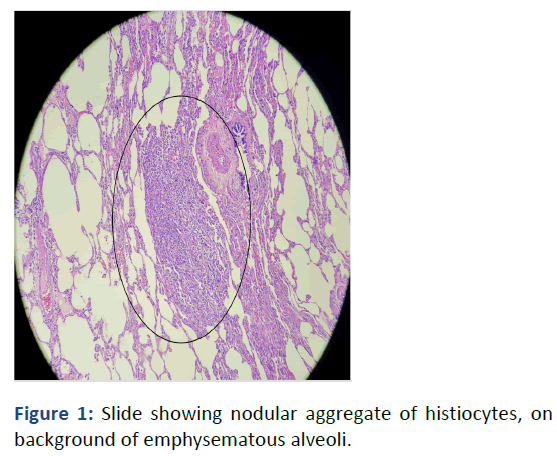
Figure 1: Slide showing nodular aggregate of histiocytes, on background of emphysematous alveoli.
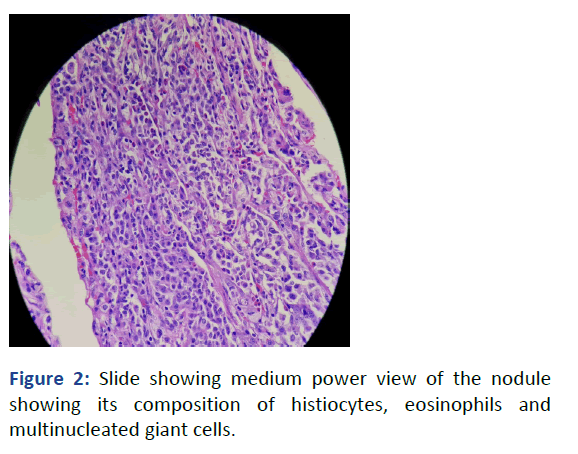
Figure 2: Slide showing medium power view of the nodule showing its composition of histiocytes, eosinophils and multinucleated giant cells.
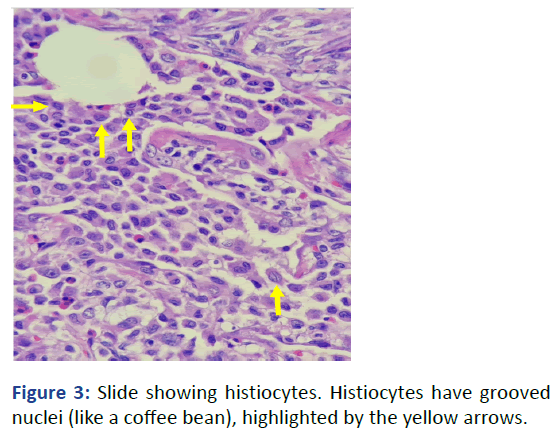
Figure 3: Slide showing histiocytes. Histiocytes have grooved nuclei (like a coffee bean), highlighted by the yellow arrows.
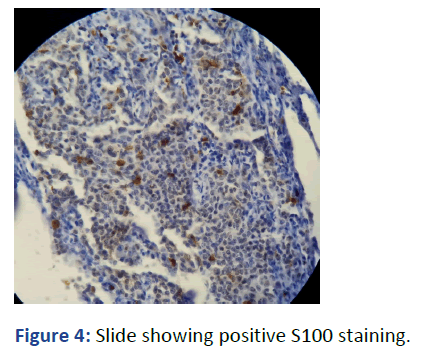
Figure 4: Slide showing positive S100 staining.
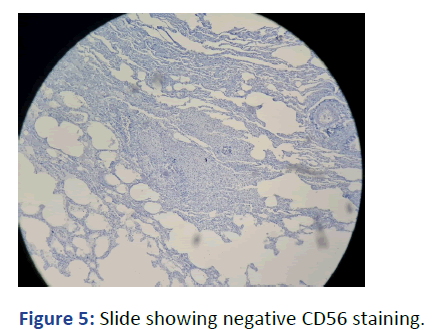
Figure 5: Slide showing negative CD56 staining.
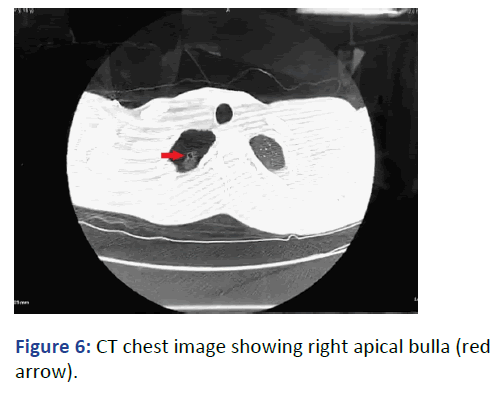
Figure 6: CT chest image showing right apical bulla (red arrow).
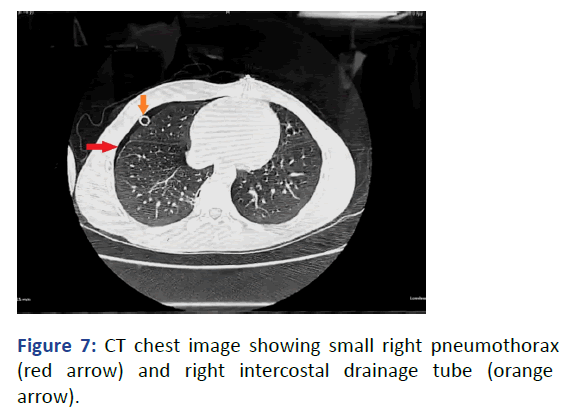
Figure 7: CT chest image showing small right pneumothorax (red arrow) and right intercostal drainage tube (orange arrow).
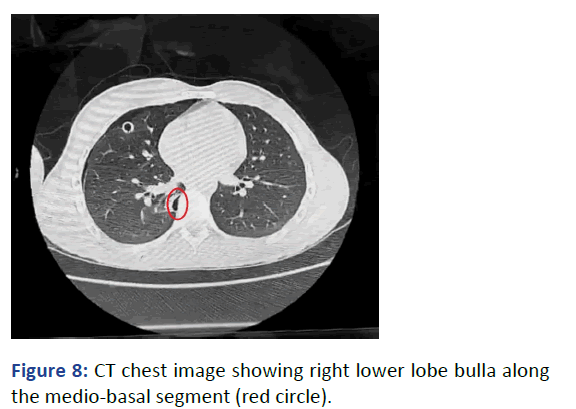
Figure 8: CT chest image showing right lower lobe bulla along the medio-basal segment (red circle).
Spirometry Test
FEV1/FVC>LLN. FVC is decreased based on % Pred and Z-score. There is no significant response to inhaled bronchodilation. Test is suggestive of non-obstructive ventilatory pattern, likely mild restriction.
Follow Up
Patient is currently asymptomatic and is doing well 6 months post procedure. Repeat chest radiograph shows no abnormalities.
Pulmonary Langerhans Cell Histiocytosis (PLCH) is a rare cystic lung disease usually occurring in the young adult population. It can affect the lungs in isolation or be widespread as part of a multisystemic disease and is characterized by infiltration of tissues by bone marrow derived langerhans cells, with an accompanying strong inflammatory response.
Tobacco smoking plays an important role in the development of pulmonary langerhans cell histiocytosis, as it causes an inflammatory cell accumulation in the lungs, one of which are langerhans cells (a type of dendritic cell or antigen presenting cell). These cells secrete a multitude of cytokines, chemokines, and metalloproteinases, culminating in inflammation, granuloma formation and the cystic destruction of the lung (and potentially other tissues). Interestingly, the intensity and smoking duration may not influence the development of PLCH. Isolated PLCH in children is very rare and the disease may be associated with passive exposure to tobacco smoke in most of them.
The most common presenting symptoms are dry cough (50% to 70%), reduced exercise tolerance (40% to 80%), exertional dyspnoea (40% to 87%), fatigue (50% to 80%), rarer presentations including weight loss, chest pain, night sweats and fever. As in this case, patients can also be diagnosed after spontaneous pneumothorax (10% to 20% of cases).
Chest radiography is of limited use in the radiological diagnosis of PLCH, however in advanced disease symmetrical, reticular, cystic, and nodular lesions may be seen in the upper and middle lung fields. Hilar and mediastinal lymphadenopathy can rarely be seen. There is usually preservation of lung volumes, or hyperinflation may be present. High resolution CT plays a major role in the diagnosis of PLCH, showing reticulonodular opacities and cysts with a predilection for the upper and middle zones of the lungs. Early in the disease process, nodules are predominant (1 mm-10 mm in diameter, centrilobular distribution) with cysts being more predominant in the later stages of the disease (usually less than 10 mm in diameter, but may measure up to 2 cm-3 cm in size, usually thin walled). Other findings on HRCT may include ground glass and/or reticular opacities, mosaic attenuation, septal line thickening, emphysema, coalescent cysts, fibrosis, and honeycombing.
Open lung biopsy is the gold standard for a definitive diagnosis of PLCH, however its feasibility is determined on a case by case basis, especially in our setting where there is very limited operating theatre time. A definite diagnosis of PLCH requires adequate clinical presentation with the identification of Langerhans cells in biopsy specimens that exhibit either CD207 (langerin) or CD1a.
A probable diagnosis of PLCH is based on adequate clinical presentation with characteristic radiological findings on chest CT.
Smoking cessation is the most important recommendation for patients with PLCH, with a large proportion (~50%) of patients demonstrating spontaneous resolution or stabilization of disease.
Corticosteroids are frequently used and appear beneficial, however, in patients with rapidly progressive disease, no proven therapy has been found. Chemotherapeutic agents (vinblastine, methotrexate, cyclophosphamide, cladribine, and etoposide), and, in selected patients, lung transplantation are all possible treatment options. Additionally, there are recent publications reviewing the use of novel agents such as mitogen-activated kinase inhibitors (trametinib, cobimetinib), BRAF kinase inhibitors (vemurafenib, dabrafenib), and tyrosine kinase inhibitors (imatinib).
These cases illustrate two very different presentations of this disease along with different work up. The first is an older man with a strong history of smoking, the other a teenage nonsmoker. It is also interesting to note the teenager’s history of COVID-19 pneumonia 2 months prior to his presentation to hospital. In an extensive literature review, we have not encountered any cases of COVID-19 causing PLCH, however, due to the novelty of the virus and the fact that most post- COVID patients do not routinely undergo lung biopsies, it is impossible to rule this out. The inflammatory cell accumulation in the lungs that occurs in COVID 19 pneumonia would fit with the pathogenesis of PLCH. Also importantly, these cases clearly illustrate the different routes of diagnostic evaluation and diagnosis of PLCH. The first is a clinical and radiological probable diagnosis based on CT findings as a biopsy was not warranted in this case. The second is a histological diagnosis, however, due to the limited IHC staining available, is not definitive (CD 207 stain, aka langerin necessary for definitive diagnosis).
The authors declare that they have no competing interests relevant to these case reports and the publication thereof.
Dr. H Jacobs conceived and planned the work that led to the paper wrote the paper and reviewed successive versions and took part in the revision process approved the final version.
Dr. W Chin Soo planned the work that led to the paper helped write the paper and reviewed successive versions and took part in the revision process approved the final version.
Informed consent has been obtained from the patient involved as well as parents for this case to be written and published.
Dr. Sateesh Sakhamuri reviewer.
[Crossref] [Google Scholar] [PubMed]
[Crossref] [Google Scholar] [PubMed]
[Crossref] [Google Scholar] [PubMed]
[Crossref] [Google Scholar] [PubMed]
[Crossref] [Google Scholar] [PubMed]
[Crossref] [Google Scholar] [PubMed]
Citation: Jacobs H, Soo WC (2023) Two Cases of a Rare Condition: Pulmonary Langerhans Cells Histiocytosis. Qual Prim Care. 31:036.
Copyright: © 2023 Jacobs H, et al. This is an open-access article distributed under the terms of the Creative Commons Attribution License, which permits unrestricted use, distribution, and reproduction in any medium, provided the original author and source are credited.